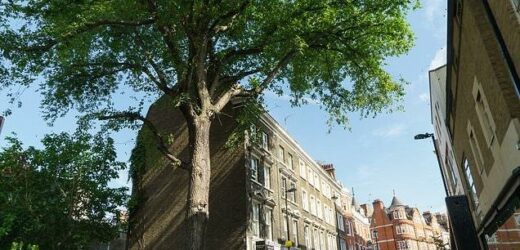Experts grow trees resistant to Dutch elm disease as part of plans to repopulate the countryside after 100million were wiped out by killer fungus
- 100 million elms were wiped out in the 1960s and 1970s by Dutch elm disease
- The killer fungus, spread by beetles changed the UK’s countryside landscape
- Scientists and landowners from the across the UK, Netherlands and Spain gathered at Kew Gardens in June to devise a strategy for the elm comeback
An elm renaissance is taking shape after the Dutch elm disease wiped out a large proportion of the beloved tree species nearly 60 years ago.
Once a common sight across the English countryside, up to 100 million were wiped out in the 1960s and 1970s by Dutch elm disease, a fungus spread by beetles.
Now, experts have launched a research project to see if field elms and wych elms could once again thrive across British cities and hedgerows.
Scientists and landowners from the across the UK, Netherlands and Spain gathered at Kew Gardens in June to devise a strategy for the elm comeback – even though the disease has not gone away.
‘There was lots of effort after the really bad Dutch elm disease outbreak in the Sixties and Seventies to develop resistant elms. But then the research died off a little bit, people gave up hope,’ Richard Buggs, a researcher at Kew Gardens told the Times.
An elm renaissance is taking shape after the Dutch elm disease wiped out a large proportion of the beloved tree species nearly 60 years ago
‘Now we’re trying to get it going again, with technologies that weren’t available then.’
One potential key to restoring one of the UK’s most-loved tree species is a plantation site home to roughly one hundred elms that have proved resistant to the deadly disease.
Run by Andrew Brookes, a conservationist, the site is located between a waste disposal facility and a mosque near Portsmouth.
Researchers are currently looking at whether they could use elms from Spain that have proved genetically resistant.
Although researchers have not yet identified which genes help protect against the disease, they are starting to gather information on traits that could help.
For example, they know that resistant trees appear to be able to block up the tubes inside them that conduct water and nutrients, slowing down the growth of the fungus, the Times reported.
‘If we did discover certain genes involved in resistance, we could use that knowledge to accelerate a breeding programme,’ said Mr Buggs.
A Dundee University team did create a genetically modified elm tree in 2001 but British public hostility against GM meant it was never used, the Times said.
However, modern gene-editing, which does not involve genes from different species and which the UK government is keen on, could achieve the same results.
Although elms from Spain is a possibility, a big question remains on how well they would grow in the UK’s soils and climate.
Once a common sight across the English countryside, up to 100 million were wiped out in the 1960s and 1970s by Dutch elm disease, a fungus spread by beetles
Mr Brookes told the Times that the signs are ‘promising’.
He said: ‘Some do better than others, but overall they’ve grown very well’.
Mr Brookes added that he hopes the renaissance could save the white-letter hairstreak, a butterfly that relies on the leaves of mature elms in late Spring.
Tests are already under way to see if the elms from Spain can support the rare butterfly.
Studying populations of two beetle species that spread Dutch elm disease is also key. ‘We know the pathogen is still as virulent today,’ Joan Webber, of Foresty Research, a government agency working on the £255,000 project funded by the Department for Environment, Food and Rural Affairs, told the Times.
The researchers are now relying on the public to help map the location of the UK’s remaining elms.
Scientists and landowners from the across the UK, Netherlands and Spain gathered at Kew Gardens in June to devise a strategy for the elm comeback – even though the disease has not gone away
Many stunted examples are in hedgerows, stuck in a perpetual loop where the disease kills them when they are about 12 years old, before the tree regenerates from its roots.
They are also an ideal street tree, resilient enough to cope with water and energy companies digging around their roots – growing up to 30 metres high.
Brighton and Hove has many old elms, dating back to Victorian times.
If the team is successful, the fast-growing nature of elms could mean that in 20 to 30 years there could be a ‘significant’ number in the landscape once again, according to Webber.
Bringing back elms would not only physically appease landscapes, but tackle climate change and help meet government tree-planting targets , said Buggs.
‘We want to plant more trees to absorb carbon, and elm would be great to plant because it grows fast, has valuable timber, and when you turn it into timber the carbon is sequestered for centuries.’
Source: Read Full Article





